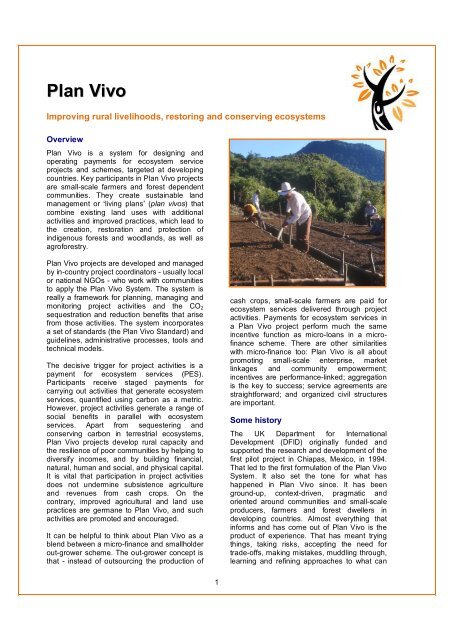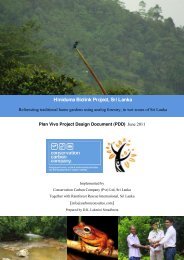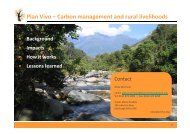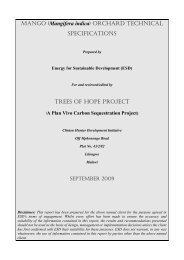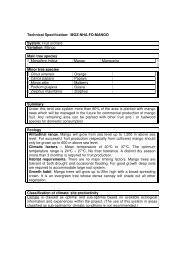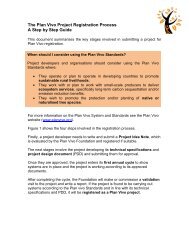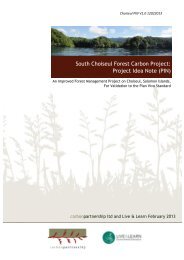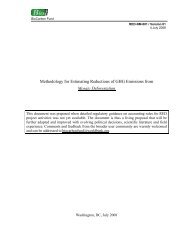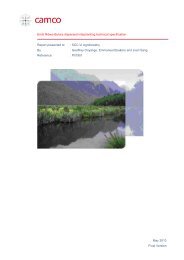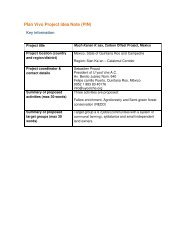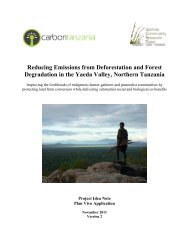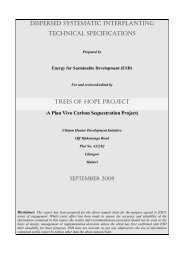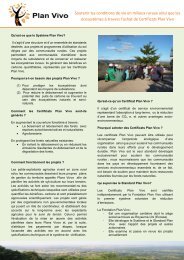is a not-for-profit company - Plan Vivo
is a not-for-profit company - Plan Vivo
is a not-for-profit company - Plan Vivo
- No tags were found...
You also want an ePaper? Increase the reach of your titles
YUMPU automatically turns print PDFs into web optimized ePapers that Google loves.
<strong>Plan</strong> <strong>Vivo</strong>Improving rural livelihoods, restoring and conserving ecosystemsOverview<strong>Plan</strong> <strong>Vivo</strong> <strong>is</strong> a system <strong>for</strong> designing andoperating payments <strong>for</strong> ecosystem serviceprojects and schemes, targeted at developingcountries. Key participants in <strong>Plan</strong> <strong>Vivo</strong> projectsare small-scale farmers and <strong>for</strong>est dependentcommunities. They create sustainable landmanagement or living plans (plan vivos) thatcombine ex<strong>is</strong>ting land uses with additionalactivities and improved practices, which lead tothe creation, restoration and protection ofindigenous <strong>for</strong>ests and woodlands, as well asagro<strong>for</strong>estry.<strong>Plan</strong> <strong>Vivo</strong> projects are developed and managedby in-country project coordinators - usually localor national NGOs - who work with communitiesto apply the <strong>Plan</strong> <strong>Vivo</strong> System. The system <strong>is</strong>really a framework <strong>for</strong> planning, managing andmonitoring project activities and the CO 2sequestration and reduction benefits that ar<strong>is</strong>efrom those activities. The system incorporatesa set of standards (the <strong>Plan</strong> <strong>Vivo</strong> Standard) andguidelines, admin<strong>is</strong>trative processes, tools andtechnical models.The dec<strong>is</strong>ive trigger <strong>for</strong> project activities <strong>is</strong> apayment <strong>for</strong> ecosystem services (PES).Participants receive staged payments <strong>for</strong>carrying out activities that generate ecosystemservices, quantified using carbon as a metric.However, project activities generate a range ofsocial benefits in parallel with ecosystemservices. Apart from sequestering andconserving carbon in terrestrial ecosystems,<strong>Plan</strong> <strong>Vivo</strong> projects develop rural capacity andthe resilience of poor communities by helping todiversify incomes, and by building financial,natural, human and social, and physical capital.It <strong>is</strong> vital that participation in project activitiesdoes <strong>not</strong> undermine subs<strong>is</strong>tence agricultureand revenues from cash crops. On thecontrary, improved agricultural and land usepractices are germane to <strong>Plan</strong> <strong>Vivo</strong>, and suchactivities are promoted and encouraged.It can be helpful to think about <strong>Plan</strong> <strong>Vivo</strong> as ablend between a micro-finance and smallholderout-grower scheme. The out-grower concept <strong>is</strong>that - instead of outsourcing the production ofcash crops, small-scale farmers are paid <strong>for</strong>ecosystem services delivered through projectactivities. Payments <strong>for</strong> ecosystem services ina <strong>Plan</strong> <strong>Vivo</strong> project per<strong>for</strong>m much the sameincentive function as micro-loans in a microfinancescheme. There are other similaritieswith micro-finance too: <strong>Plan</strong> <strong>Vivo</strong> <strong>is</strong> all aboutpromoting small-scale enterpr<strong>is</strong>e, marketlinkages and community empowerment;incentives are per<strong>for</strong>mance-linked; aggregation<strong>is</strong> the key to success; service agreements arestraight<strong>for</strong>ward; and organized civil structuresare important.Some h<strong>is</strong>toryThe UK Department <strong>for</strong> InternationalDevelopment (DFID) originally funded andsupported the research and development of thefirst pilot project in Chiapas, Mexico, in 1994.That led to the first <strong>for</strong>mulation of the <strong>Plan</strong> <strong>Vivo</strong>System. It also set the tone <strong>for</strong> what hashappened in <strong>Plan</strong> <strong>Vivo</strong> since. It has beenground-up, context-driven, pragmatic andoriented around communities and small-scaleproducers, farmers and <strong>for</strong>est dwellers indeveloping countries. Almost everything thatin<strong>for</strong>ms and has come out of <strong>Plan</strong> <strong>Vivo</strong> <strong>is</strong> theproduct of experience. That has meant tryingthings, taking r<strong>is</strong>ks, accepting the need <strong>for</strong>trade-offs, making m<strong>is</strong>takes, muddling through,learning and refining approaches to what can1
work. <strong>Plan</strong> <strong>Vivo</strong> recogn<strong>is</strong>es that organicdevelopment <strong>is</strong> key to its success as a systemand standard.Today there are four operational <strong>Plan</strong> <strong>Vivo</strong>projects that sell <strong>Plan</strong> <strong>Vivo</strong> Certificates, inMexico, Uganda, Mozambique and Tanzania.Several others are in various stages ofdevelopment, including two in Malawi and oneeach in Cameroon, Rwanda and Nicaragua.How are projects financed?<strong>Plan</strong> <strong>Vivo</strong> projects source funding <strong>for</strong> PESlargely by providing <strong>Plan</strong> <strong>Vivo</strong> Certificates tobuyers, who may buy <strong>Plan</strong> <strong>Vivo</strong> Certificates <strong>for</strong>voluntary carbon offsetting, corporate socialresponsibility, or simply to support PES in anarea, or in respect of ecosystem services thatthey have an interest in supporting. ACertificate represents one tCO 2 e and a bundleof various other environmental and socialbenefits that are difficult to price on their own.Projects require some capital to cover upfrontdevelopment costs. Typically the initial capital<strong>is</strong> from ODA sources, philanthropic donors,conservation groups or - in the case of theMozambique project, <strong>for</strong> example - privatecapital.Once they are establ<strong>is</strong>hed, projects need to beable to cover ongoing project managementcosts and provide incentives <strong>for</strong> producers toparticipate in project activities. In the earlyphases of a project, incentives come primarilyfrom direct payments <strong>for</strong> ecosystem servicesand other <strong>for</strong>ms of project support, such astraining or access to community funds.As projects and sustainable land managementpractices become more establ<strong>is</strong>hed, sources ofincome diversify and the importance of theecosystem/carbon payments <strong>for</strong> householdsand communities will often recede.Environmental and social benefits<strong>Plan</strong> <strong>Vivo</strong> strengthens capacity and buildsdifferent <strong>for</strong>ms of capital through a variety ofmeans.Financial capital PES create opportunities toinvest in more productive and sustainable landuse systems, community enterpr<strong>is</strong>es andrevenue generating activities, through incomediversification (agricultural, timber and nontimber<strong>for</strong>est products), and through savingsfrom the prov<strong>is</strong>ion of cheap and sustainablebio-energyNatural capital through biodiversitymaintenance, greater natural environmentalresilience, more balanced agricultural andagro<strong>for</strong>estry systems, watershed protection andmo<strong>is</strong>ture retention especially important in areasprone to drought and r<strong>is</strong>k of floods, soilstabilization and erosion control, increasedproductivity and the ability of lands to supportagriculture <strong>for</strong> longer periods, the prov<strong>is</strong>ion ofshade <strong>for</strong> animals and cropsHuman and social capital through povertyreduction, livelihood improvements and higherstandards of living, increased resilience andability to adapt to climate change, knowledgesharing, transfer of skills, participatory planning,the strengthening of community structures andfinancial networks, reduced dependency on aidand government support, and by drawingattention to the importance of community andsmallholder land use rights and tenurePhysical capital through the mobilization oftools, equipment, seedlings and other thingswhich help to improve sustainable resourcemanagement capacityThe livelihood benefits of <strong>Plan</strong> <strong>Vivo</strong> projects arewell understood. The biodiversity benefits areoften overlooked and warrant special mention.Native trees are planted which are suitable <strong>for</strong>local wildlife. Projects help create and link<strong>is</strong>lands of biodiversity. They also providebuffer zones <strong>for</strong> local biodiversity hotspots byeasing pressures of encroachment andunsustainable fuel wood collection.2
<strong>Plan</strong> <strong>Vivo</strong> and PESThere are various ways to think about anddescribe payments <strong>for</strong> ecosystem services(PES). In the <strong>Plan</strong> <strong>Vivo</strong> framework, PES can beseen quite simply as a kind of subsidy orcompensation <strong>for</strong> actions that give r<strong>is</strong>e toenvironmental services. The importance of theword actions can<strong>not</strong> be over-emphasized;<strong>Plan</strong> <strong>Vivo</strong> <strong>is</strong> about mobilization and activities; it<strong>is</strong> about rewarding rural farmers andcommunities <strong>for</strong> successfully doing things theywould <strong>not</strong> ordinarily do, because of a lack offinancial wherewithal, capacity or support.Producers receive staged payments based ontheir actions and attainment of agreedper<strong>for</strong>mance milestones.The metric of CO 2 <strong>is</strong> used as currency <strong>for</strong>transacting PES partly because it <strong>is</strong> widelyrecogn<strong>is</strong>ed, and can be understood andmonitored (relatively) easily by people on theground. It <strong>is</strong> a useful indicator of howsuccessful project actions are. Carbon servesas both a means and an end. It <strong>is</strong> an end as itrepresents and corresponds to a climatechange mitigation benefit. Carbon finance <strong>is</strong> ameans of getting money to peasant farmersand communities, maintaining biodiversity,restoring natural and managed (agricultural)ecosystems, improving rural livelihoods, andrein<strong>for</strong>cing the rights of people who are thestewards of <strong>for</strong>ests and lands and whosesurvival depends directly on natural resources.<strong>Plan</strong> <strong>Vivo</strong> scalabilityOne of the great strengths of the <strong>Plan</strong> <strong>Vivo</strong> <strong>is</strong>its scalability, which <strong>is</strong> closely linked to the factthat the system <strong>is</strong> replicable, transferable andhelps achieve economic and in<strong>for</strong>mationefficiencies. Much like a micro-finance system,<strong>Plan</strong> <strong>Vivo</strong> thrives because it <strong>is</strong> able to efficientlymobilize and aggregate the enterpr<strong>is</strong>e andcorresponding environmental benefits ofthousands of producers. The systemstandard<strong>is</strong>es and simplifies project operations,making them more efficient to admin<strong>is</strong>ter,understand and communicate.Projects are based on systematized accountingprocesses both <strong>for</strong> carbon and themanagement of payments to producers. Theplan vivos (management plans) serve as thebasic building blocks <strong>for</strong> projects and are linkedto approved technical specifications(methodologies) that are used to calculatecarbon benefits. A <strong>Plan</strong> <strong>Vivo</strong> database providesa basic infrastructure <strong>for</strong> allocating fundsacross producers and <strong>for</strong> recording, managingand d<strong>is</strong>seminating data from the monitoring ofproject activities. These admin<strong>is</strong>trativeprocesses, technical models and tools facilitatereplication and extension of project activities tonew areas.Project extension <strong>is</strong> also made considerablyeasier by in<strong>for</strong>mation efficiencies that ar<strong>is</strong>e asproducers become a powerful driving <strong>for</strong>ce <strong>for</strong>communication, understanding and thetransm<strong>is</strong>sion of in<strong>for</strong>mation. When producers ina particular area learn about and are able tosee the benefits of a project operating ina<strong>not</strong>her area, they generally feel encouraged tobecome involved and more receptive tolearning and understanding how the systemworks.The <strong>Plan</strong> <strong>Vivo</strong> project in Mexico started with ahandful of families and has recruited over 700over the year. The Mozambique project hasgrown to include 1,350 producers since it wasinitiated in 2001. The producer recruitmentnumbers <strong>for</strong> the <strong>Plan</strong> <strong>Vivo</strong> project in Ugandaillustrate the sort of growth potential that <strong>is</strong>possible in <strong>Plan</strong> <strong>Vivo</strong> projects:2003 30 new producers2004 54 new producers2006 18 new producers2007 34 new producers2008 268 new producers2009 100 new producersTotal 504 producers3
The <strong>Plan</strong> <strong>Vivo</strong> Foundation andBioClimate Research & DevelopmentThe <strong>Plan</strong> <strong>Vivo</strong> Foundation governs andoversees the development of the <strong>Plan</strong> <strong>Vivo</strong>System and Standards. It reviews and reg<strong>is</strong>tersprojects, and also assesses project monitoringdata in order to <strong>is</strong>sue <strong>Plan</strong> <strong>Vivo</strong> Certificates.The Foundation also approves third-partyverifiers and coordinates project validation. Itd<strong>is</strong>seminates in<strong>for</strong>mation and promotes andsupports the <strong>Plan</strong> <strong>Vivo</strong> System, Standard andprojects. The Foundation itself can<strong>not</strong> getdirectly involved in project developmentbecause of its governance and certificationfunction.BR&D, a Scott<strong>is</strong>h <strong>company</strong>, strives to facilitateknowledge transfer, increase communitycapacity and make project developmentaccessible and af<strong>for</strong>dable <strong>for</strong> organ<strong>is</strong>ations indeveloping countries. In future BR&D may lookat helping develop routes to market <strong>for</strong> <strong>Plan</strong><strong>Vivo</strong> (Fairtrade) commodities and products.BioClimate Research & Development (BR&D)<strong>is</strong> a <strong>not</strong>-<strong>for</strong>-<strong>profit</strong> <strong>company</strong> mandated by the<strong>Plan</strong> <strong>Vivo</strong> Foundation to ass<strong>is</strong>t organ<strong>is</strong>ationsaround the world to develop <strong>Plan</strong> <strong>Vivo</strong> projects.For more in<strong>for</strong>mation v<strong>is</strong>it www.planvivo.org<strong>Plan</strong> <strong>Vivo</strong> Foundation18B Liberton BraeTower Mains StudiosEdinburgh EH16 6AEUnited KingdomTel +44 (0)131 672 37824


